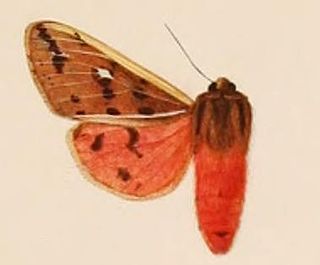Related Research Articles
Scoliosia is a monotypic moth genus in the subfamily Arctiinae erected by George Hampson in 1914. Its single species, Scoliosia brunnescens, was first described by Walter Rothschild in 1912. It is found in Papua and Papua New Guinea.
Striosia is a monotypic moth genus in the subfamily Arctiinae erected by George Hampson in 1914. Its single species, Striosia irrorata, was first described by Rothschild in 1912. It is found in New Guinea, where it is known from Papua and Papua New Guinea.
Trichaeta is a genus of moths in the subfamily Arctiinae. It was described by Charles Swinhoe in 1892.

Spilaethalida turbida is a moth of the family Erebidae first described by Arthur Gardiner Butler in 1882.

Spilosoma alberti is a moth of the family Erebidae. It was described by Walter Rothschild in 1914. It is found on Papua New Guinea, where it is restricted to mountainous areas at high altitudes ranging from 1,200 to 2,150 meters.
Spilosoma fraterna is a moth of the family Erebidae first described by Walter Rothschild in 1910. It is found on Papua New Guinea.
Amerila timolis, or Timolis' frother, is a moth of the subfamily Arctiinae. It was described by Walter Rothschild in 1914. It is found in New Guinea and Queensland, Australia.
Chrysoscota albomaculata is a moth of the family Erebidae.
Chrysoscota conjuncta is a moth of the family Erebidae. It was described by Walter Rothschild in 1912. It is found in Papua New Guinea. The habitat consists of mountainous and lowland areas.
Cyme basitesselata is a moth of the subfamily Arctiinae.
Lambulodes brunneomarginata is a moth of the family Erebidae. It was described by Walter Rothschild in 1912. It is found in New Guinea, where it has been recorded from Waigeo and on mainland New Guinea. The habitat consists of mountainous areas.
Lambulodes sericea is a moth of the family Erebidae. It was described by Walter Rothschild in 1912. It is found in Papua New Guinea and it is also found on Mount Goliath in Papua.
Monosyntaxis persimilis is a moth of the family Erebidae. It was described by Walter Rothschild in 1912. It is found in New Guinea, where it is distributed in mountainous areas in the central part of the island, up to the Wandammen Mountains in the west. It is also found in Papua New Guinea.
Nyctemera hyalina is a moth of the family Erebidae first described by George Thomas Bethune-Baker in 1910. It is found on Sulawesi, Seram, Buru, the Moluccas and in New Guinea.
Poliosia umbra is a moth in the family Erebidae. It was described by Walter Rothschild in 1915. It is found in New Guinea, where it is only known from the surroundings of the Utakwa River.
Scoliacma albogrisea is a moth in the family Erebidae. It was described by Walter Rothschild in 1912. It is found in Papua New Guinea.
Scoliacma fuscofascia is a moth in the family Erebidae. It was described by Walter Rothschild in 1913. It is found in Papua New Guinea, where it is restricted to the Central Mountain Range.
Scoliacma ligneofusca is a moth in the family Erebidae. It was described by Walter Rothschild in 1912. It is found in Papua New Guinea. The habitat consists of coastal lowland areas.
Spilarctia owgarra is a moth in the family Erebidae. It was described by George Thomas Bethune-Baker in 1908. It is found in New Guinea. The habitat consists of mountainous areas.
Teratopora unifascia is a moth in the family Erebidae. It was described by Walter Rothschild in 1912. It is found in New Guinea, where it has been recorded from Papua New Guinea and Papua. The habitat consists of lowland areas.
References
- ↑ Savela, Markku (December 21, 2015). "Ceryx aurantiobasis Rothschild, 1910". Lepidoptera and Some Other Life Forms. Retrieved October 30, 2019.
- ↑ De Vos, Rob. "Trichaeta aurantiobasis (Rothschild, 1910) | The Wasp Moths (Erebidae, Arctiinae, Syntomini) of Papua Indonesia". Papua-Insects.nl. The Papua Insects Foundation. Retrieved October 30, 2019.
- Pitkin, Brian & Jenkins, Paul. "Search results Family: Arctiidae". Butterflies and Moths of the World. Natural History Museum, London.
| | This Arctiinae-related article is a stub. You can help Wikipedia by expanding it. |